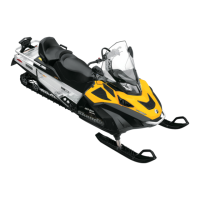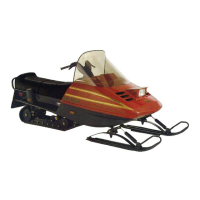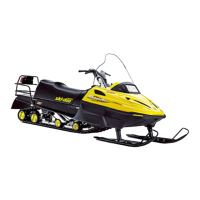RIDING THE VEHICLE
Frozen Water
Traveling frozen lakes and rivers can be
fatal. Avoid waterways. If you are in
an unfamiliar area, ask the local author-
ities or residents about the ice condi-
tion, inlets, outlets, springs, fast mov-
ing currents or other hazards. Never
attempt to operate your snowmobile
on ice that may be too weak to sup-
port you and the vehicle. Operating
a snowmobile on ice or icy surfaces
can be very dangerous if you do not
observe certain precautions. The very
nature of ice is foreign to good con-
trol of a snowmobile or any vehicle.
Traction for starting, turning or stop-
ping is much less than that on snow.
Thus, these distances can be multi-
plied manyfold. Steering is minimal,
and uncontrolled spins are an ever
present danger. When operating on
ice, drive slowly with caution. Allow
yourself plenty of room for stopping
and turning. This is especially true at
night.
Hard Packed Snow
Don't underestimate hard packed
snow. It can be difficult to negotiate
as both skis and track do not have as
much traction. Best advice is to slow
down and avoid rapid acceleration,
turning or braking.
Uphill
There are two types of hills you can en-
counter — the open hill on which there
are few trees, cliffs or other obstacles,
and a hill that can only be climbed di
-
rectly. On an open hill, the approach is
to climb it by side hilling or slaloming.
Approachatan angle. Adopt a knee
ling
position. Keep your weight on the up-
hill side at all times. Maintain a steady,
safe speed. Continue as far as y
ou can
in this direction, then switch to an op-
posite hill angle and riding position.
A direct climb could present problems.
Choose the standing position, acceler-
ate before you start the climb and then
reduce throttle pressure to prevent
track slippage.
In either case, vehicle speed should be
as fast as the incline demands. Always
slow down as you reach the crest. If
you cannot proceed further, don't spin
your track. Turn the engine off, freethe
skis by pulling them out and downhill,
place the rear of the snowmobile uphill
restart the engine and ease it out with
slow even throttle pressure. Position
yourself to avoid tipping over, then de-
scend.
Downhill
Downhill driving requires that you have
full control of your vehicle at all times.
On steeper hills, keep your center of
gravity low and both hands on the han-
dlebar. Maintain slight throttle pres-
sure and allow the machine to run
downhill with the engine operating.
If a higher than safe speed is reached,
slow down by braking but apply the
brake with frequent light pressure.
Never jam the brake and lock the track.
Side Hill
When crossing a side hill or travers-
ing up or downhill, certain procedures
must be followed. All riders should
lean towards the slope as required for
stability. The preferred operating po-
sitions are the kneeling position, with
thekneeofthedownhilllegonthe
seat and the foot of the uphill leg on
the running board, or the posting posi-
tion. Be prepared to shift your weight
quickly as needed. Side hills and
steep
slopes are not recommended for a be-
ginner or a novice snowmobiler.
Slush
Slush should be avoided at all
times.
Always check for slush before starting
across any lake or river. If dark spots
appearinyourtracks,geto
ff the ice
immediately. Ice and water can be
________
SAFETY INF
ORMATION
________
17

